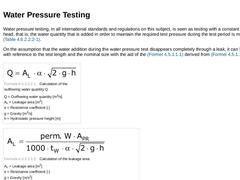
|
Water pressure testing, in all international standards and regulations on this subject, is seen as testing with a constant pressure head, that is, the water quantity that is added in order to maintain the required test pressure during the test period is measured (Tabelle 4.5.1.1.1). On the assumption that the water addition during the water pressure test disappears completely through a leak, it can be calculated with reference to the test length and … |
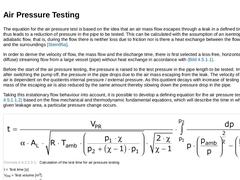
|
The equation for the air pressure test is based on the idea that an air mass flow escapes through a leak in a defined time period and thus leads to a reduction of pressure in the pipe to be tested. This can be calculated with the assumption of an isentropic and adiabatic flow, that is, during the flow there is neither loss due to friction nor is there a heat exchange between the flowing medium and the surroundings [Stein95a]. In order to derive the … |
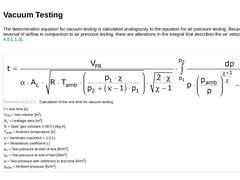
|
The determination equation for vacuum testing is calculated analogously to the equation for air pressure testing. Because of the reversal of airflow in comparison to air pressure testing, there are alterations in the integral that describes the air velocity (Formel 4.5.1.1.3). (Formula: Calculation of the test time for vacuum testing) Because of the differing physical properties of the test media - water as incompressible, air as compressible medium - … |
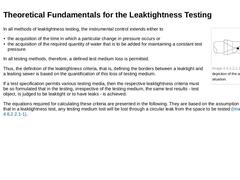
|
(Image: Principle depiction of the assumed damage situation.) In all methods of leaktightness testing, the instrumental control extends either to - the acquisition of the time in which a particular change in pressure occurs or
- the acquisition of the required quantity of water that is to be added for maintaining a constant test pressure.
In all testing methods, therefore, a defined test medium loss is permitted. Thus, the definition of the leaktightness … |
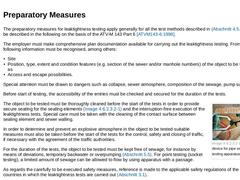
|
The preparatory measures for leaktightness testing apply generally for all the test methods described in Abschnitt 4.5.1.1. They will be described in the following on the basis of the ATV-M 143 Part 6 [ATVM143-6:1998]. The employer must make comprehensive plan documentation available for carrying out the leaktightness testing. From these, the following information must be recognised, among others: - Site
- Position, type, extent and condition features (…
|
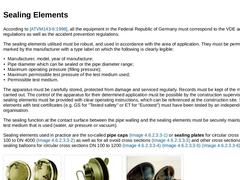
|
According to [ATVM143-6:1998], all the equipment in the Federal Republic of Germany must correspond to the VDE and DIN regulations as well as the accident prevention regulations. The sealing elements utilised must be robust, and used in accordance with the area of application. They must be permanently marked by the manufacturer with a type label on which the following is clearly legible: - Manufacturer, model, year of manufacture;
- Pipe diameter which …
|
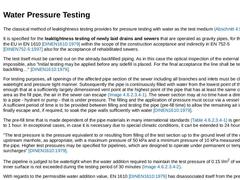
|
The classical method of leaktightness testing provides for pressure testing with water as the test medium (Abschnitt 4.5.1.1). It is specified for the leaktightness testing of newly laid drains and sewers that are operated as gravity pipes, for the countries of the EU in EN 1610 [DINEN1610:1979] within the scope of the construction acceptance and indirectly in EN 752-5 [DINEN752-5:1997] also for the acceptance of rehabilitated sewers. The test itself … |
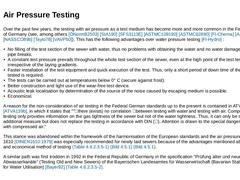
|
Over the past few years, the testing with air pressure as a test medium has become more and more common in the Federal Republic of Germany (see, among others [ÖNormB2503] [SIA190] [SFS3113E] [ASTMC109190] [ASTMC82890] [FI-Cherna] [ASTMC92485] [NASSCO89b] [Taylo78] [VAVP50]). This has the following advantages over water pressure testing [FI-Hydro] : - No filling of the test section of the sewer with water, thus no problems with obtaining the water and …
|
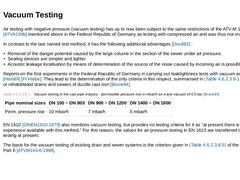
|
Air testing with negative pressure (vacuum testing) has up to now been subject to the same restrictions of the ATV-M 139 [ATVA139b] mentioned above in the Federal Republic of Germany as testing with compressed air and was thus not implemented. In contrast to the last named test method, it has the following additional advantages [Doutl83] : - Removal of the danger potential caused by the large volume in the section of the sewer under air pressure.
- Sealing …
|
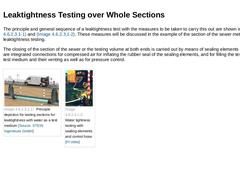
|
The principle and general sequence of a leaktightness test with the measures to be taken to carry this out are shown in Bild 4.5.1.2 and Bild 4.5.1.2. These measures will be discussed in the example of the section of the sewer method of leaktightness testing. The closing of the section of the sewer or the testing volume at both ends is carried out by means of sealing elements in which there are integrated connections for compressed air for inflating … |
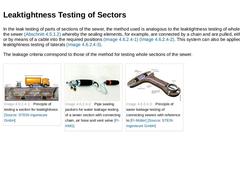
|
In the leak testing of parts of sections of the sewer, the method used is analogous to the leaktightness testing of whole sections of the sewer (Abschnitt 4.5.1.2) whereby the sealing elements, for example, are connected by a chain and are pulled, either manually, or by means of a cable into the required positions (Bild 4.5.1.3) (Bild 4.5.1.3). This system can also be applied for the leaktightness testing of laterals (Bild 4.5.1.3). The leakage criteria … |
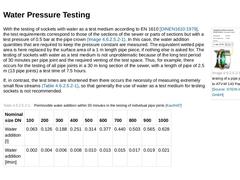
|
(Image: Leakage testing of a pipe joint - test criteria to ATV-M 143 Part and EN 1610) With the testing of sockets with water as a test medium according to EN 1610 [DINEN1610:1979], the test requirements correspond to those of the sections of the sewer or parts of sections but with a test pressure of 0.5 bar at the pipe crown (Bild 4.5.1.4.1). In this case, the water addition quantities that are required to keep the pressure constant are measured. … |
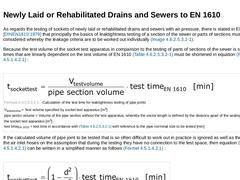
|
As regards the testing of sockets of newly laid or rehabilitated drains and sewers with air pressure, there is stated in EN 1610 [DINEN1610:1979] that principally the basics of leaktightness testing of a section of the sewer or parts of sections must be considered whereby the leakage criteria are to be worked out individually (Bild 4.5.1.4.2.1). Because the test volume of the socket test apparatus in comparison to the testing of parts of sections … |
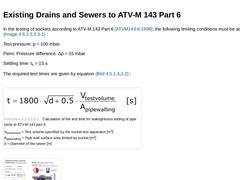
|
In the testing of sockets according to ATV-M 143 Part 6 [ATVM143-6:1998], the following limiting conditions must be adhered to (Bild 4.5.1.4.2.2) : Test pressure: p = 100 mbar Perm. Pressure difference: Δp = 15 mbar Settling time: ts = 15 s The required test times are given by equation Bild 4.5.1.4.2.2 : (Formula: Calculation of the test time for leaktightness testing of pipe joints to ATV-M 143 part 6) (Image: Leakage testing of a pipe joint - test criteria … |
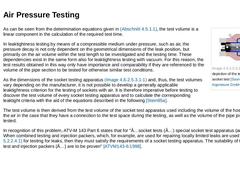
|
(Image: Schematic depiction of the test space with a socket test) As can be seen from the determination equations given in Abschnitt 4.5.1.1, the test volume is a linear component in the calculation of the required test time. In leaktightness testing by means of a compressible medium under pressure, such as air, the pressure decay is not only dependent on the geometrical dimensions of the leak position, but primarily on the air volume within the test … |
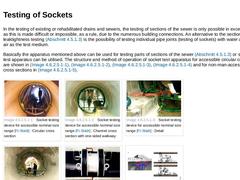
|
In the testing of existing or rehabilitated drains and sewers, the testing of sections of the sewer is only possible in exceptional cases as this is made difficult or impossible, as a rule, due to the numerous building connections. An alternative to the section method of leaktightness testing (Abschnitt 4.5.1.3) is the possibility of testing individual pipe joints (testing of sockets) with water as well as with air as the test medium. Basically the … |
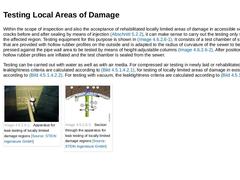
|
Within the scope of inspection and also the acceptance of rehabilitated locally limited areas of damage in accessible sewers, e.g. cracks before and after sealing by means of injection (Abschnitt 5.2.2), it can make sense to carry out the testing only specially for the affected region. Testing equipment for this purpose is shown in Bild 4.5.1.5. It consists of a test chamber of steel elements that are provided with hollow rubber profiles on the outside … |
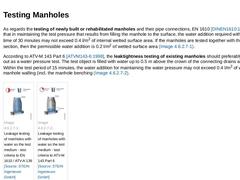
|
As regards the testing of newly built or rehabilitated manholes and their pipe connections, EN 1610 [DINEN1610:1979], specifies that in maintaining the test pressure that results from filling the manhole to the surface, the water addition required within the test time of 30 minutes may not exceed 0.4 l/m2 of internal wetted surface area. If the manholes are tested together with the sewer section, then the permissible water addition is 0.2 l/m2 of … |
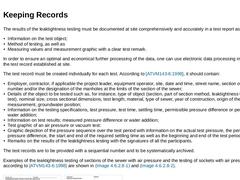
|
The results of the leaktightness testing must be documented at site comprehensively and accurately in a test report as follows: - Information on the test object;
- Method of testing, as well as
- Measuring values and measurement graphic with a clear test remark.
In order to ensure an optimal and economical further processing of the data, one can use electronic data processing in addition to the test record established at site. The test record must be created … |
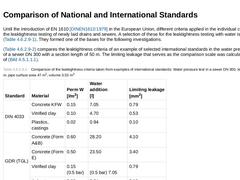
|
Until the introduction of EN 1610 [DINEN1610:1979] in the European Union, different criteria applied in the individual countries for the leaktightness testing of newly laid drains and sewers. A selection of these for the leaktightness testing with water is given in Tabelle 4.5.1.1.1. They formed one of the bases for the following investigations. Tabelle 4.5.1.8 compares the leaktightness criteria of an example of selected international standards in … |
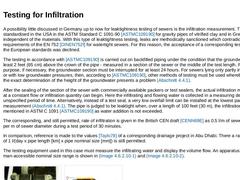
|
A possibility little discussed in Germany up to now for leaktightness testing of sewers is the infiltration measurement. This method is standardised in the USA in the ASTM Standard C 1091-90 [ASTMC109190] for gravity pipes of vitrified clay and in Great Britain independent of the materials. With this type of leaktightness testing, leaks are methodically sanctioned which contradicts the requirements of the EN 752 [DINEN752f] for watertight sewers. … |
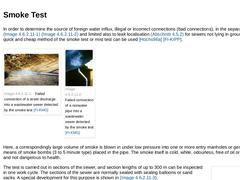
|
In order to determine the source of foreign water influx, illegal or incorrect connections (bad connections), in the separated sewers (Bild 4.5.1.10) (Bild 4.5.1.10) and limited also to leak localisation (Abschnitt 4.5.2) for sewers not lying in groundwater, the quick and cheap method of the smoke test or mist test can be used [Hochs96a] [FI-KIPP]. |
(Image: Failed connection of a street discharge into a wastewater sewer detected by the smoke test [… |
|
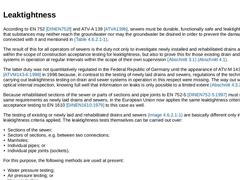
|
According to EN 752 [DINEN752f] and ATV-A 139 [ATVA139b], sewers must be durable, functionally safe and leaktight. This means that substances may neither reach the groundwater nor may the groundwater be drained in order to prevent the damage effects connected with it and mentioned in Tabelle 2.9. The result of this for all operators of sewers is the duty not only to investigate newly installed and rehabilitated drains and sewers within the scope of … |
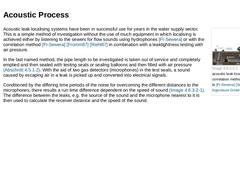
|
(Image: Principle of an acoustic leak localisation with the correlation method with reference to [FI-Sewera] [Image: S&P GmbH]) Acoustic leak localising systems have been in successful use for years in the water supply sector. This is a simple method of investigation without the use of much equipment in which localising is achieved either by listening to the sewers for flow sounds using hydrophones [FI-Sewera] or with the correlation method [FI-Sewera] [… |

|
In this group of methods, the conductance of (waste) water is utilised for localising leaks in drains and sewers. A process that has already been used for localising and quantifying leaks in sewers is the sewage probe AMS-4 [FI-seba] [Schub98] [Kramp98] [Kreut94]. The sewer to be tested is sealed off and flooded with water. According to the manufacturer, it is immaterial whether fresh water or backed up sewage is used, as it is only used as the electrical … |